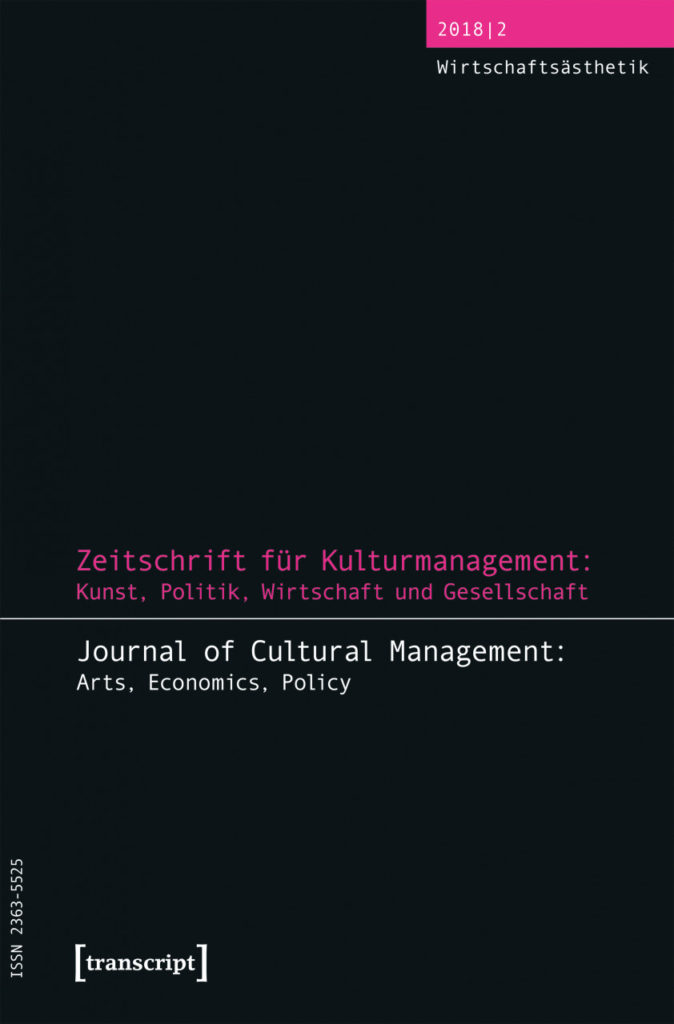Introduction
Wirtschaftsästhetik
In dem Feld „Wirtschaftsästhetik“ arbeiten unterschiedliche Personengruppen, das sind beispielsweise Künstler, Organisationsberater oder Wissenschaftler. Sie verfolgen verschiedene Ansätze, was sich auch in den Termini zeigt, die zur Bezeichnung verschiedener Akzentuierungen innerhalb des Feldes dienen, wie beispielsweise organisational art, art in company oder organizational aesthetics. International hat diese Auseinandersetzung bereits in den 1990er Jahren begonnen.[1] Mittlerweile sind zahlreiche Publikationen zu dem Thema erschienen,[2] 2012 ist das Journal Organizational Aesthetics[3] gegründet worden. Das Feld Wirtschaftsästhetik respektive Organizational Aesthetics ist dabei, sich zu begründen.
Read More-
Journal of Cultural Management 2018 (2)
http://dx.doi.org/10.14361/zkmm-2018-0201
Research Article
Journal of Cultural Management 2018 (2)
http://dx.doi.org/10.14361/zkmm-2018-0202
Research Article
Abstract
Given the growth in corporate art collecting, surprisingly little research has been conducted on how employees experience art in the workplace. This article draws on survey data collected in the context of add art Hamburg 2015, which included permanent and temporary exhibitions in 22 organizations. The findings confirm that the presence of artworks can interrupt routine ways of perceiving and using space. It triggers questions and conversations, which stimulate sensemaking processes and enrich relationships with colleagues. It also opens managers and employees to seeing everyday life and relationships with customers in a more holistic way. Furthermore, the study shows that the removal of artworks is experienced as loss and emptiness, as well as a harbinger of new potential. Finding that employees welcome more art at work, the article discusses the conditions under which people in organizations can engage with the arts as co-learners.
Journal of Cultural Management 2018 (2)
http://dx.doi.org/10.14361/zkmm-2018-0203
Research Article
Abstract
Art is brought into organizations in the shape of “artistic interventions” in order to achieve a variety of effects: creating new values, initiating learning processes, supporting restructuring processes, or fostering innovation. Several methods and practices have been developed for this purpose, in which art or artistic workshops create spaces promoting precisely these effects. Such learning spaces, experimental spaces and memory spaces pose great potential for personnel and organizational development, in that, e.g., new ideas can be developed and internalized. Based on the idea of spaces created by artistic interventions, this article analyses them from the theoretical perspective of “liminality”. This theoretical angle helps to fathom the effects experienced in artistic interventions which are difficult to evaluate. This way, the situation in which employees and themselves in artistic interventions can be framed to better understand processes of change and the opening for exploration of ideas. In addition, liminality is linked to the anthropological view of “rites of passage” (transition rites), which facilitate times of change and mark – or even constitute – transitions.
Journal of Cultural Management 2018 (2)
http://dx.doi.org/10.14361/zkmm-2018-0204
Research Article
Journal of Cultural Management 2018 (2)
http://dx.doi.org/10.14361/zkmm-2018-0205
-
Journal of Cultural Management 2018 (2)
http://dx.doi.org/10.14361/zkmm-2018-0206
Research Article
Journal of Cultural Management 2018 (2)
http://dx.doi.org/10.14361/zkmm-2018-0207
Conference Review
Journal of Cultural Management 2018 (2)
http://dx.doi.org/10.14361/zkmm-2018-0208
Conference Review
Journal of Cultural Management 2018 (2)
http://dx.doi.org/10.14361/zkmm-2018-0209
Research Article
Journal of Cultural Management 2018 (2)
http://dx.doi.org/110.14361/zkmm-2018-0210
-
Journal of Cultural Management 2018 (2)
http://dx.doi.org/10.14361/zkmm-2018-0212
Book Review
Journal of Cultural Management 2018 (2)
http://dx.doi.org/10.14361/zkmm-2018-0213
-
Journal of Cultural Management 2018 (2)
http://dx.doi.org/10.14361/zkmm-2018-0214
© 2025, Journal of Cultural Management and Cultural Policy
Keywords
- Aesthetics
- Higher Education
- Cultural Diplomacy and Foreign Cultural Policy
- Occupation
- Career and Professional Role
- Audience Development
- Audience Studies and Visitor Studies
- Visitor Motivations
- Business
- Covid Pandemic
- Democracy
- Digitalization
- Diversity
- Third Sector
- Empirical Aesthetics
- Development
- Ethics
- Evaluation
- Field Theory
- Festival
- Film
- Federalism
- Community Arts
- Societal Change
- Ideology
- Staging
- Career
- Communication
- Concert
- Creative Industries
- Creativity
- Crisis
- Culture
- arts organizations, cultural organizations
- Cultural Participation
- Cultural Change
- Fincancing The Arts
- Cultural Promotion Law
- Cultural History
- Cultural Management
- Cultural Economy
- Cultural Organizations
- Art Education
- Cultural Policy
- Cultural Production
- Cultural Sociology
- Art Education
- Cultural Understanding
- Arts Administration
- Cultural Industry
- Cultural Sciences
- Art
- Art Field
- Arts Research
- Artists
- Artistic Research
- Artistic Reputation
- Arts Management
- Arts Organizations
- Art education
- Arts Marketing
- Arts Administration
- Curating
- Leadership
- Literature
- Advocacy
- Management
- Marketing
- Market
- Media
- Methods Development
- Mexico
- Monumentalizing
- Museum
- Music
- Non-Visitor Studies
- Opera
- Orchestra
- Organization
- Political Expression
- Post-truth Politics
- Professional Role
- Audience
- Audience Development
- Law
- Government
- Role
- Socially Engaged Art
- Social Cohesion
- Social Change
- Social Cohesion
- Non-visitor Socio-demographics
- Socioculture
- State
- Symbolic capital
- Dance
- Participatory Justice
- Theatre
- Theatre Governance
- Theory Development
- Tourism
- Transformation
- Survey
- Entrepreneurship
- Urbanism
- Civil Society



